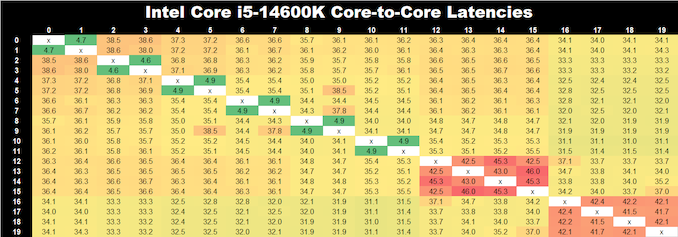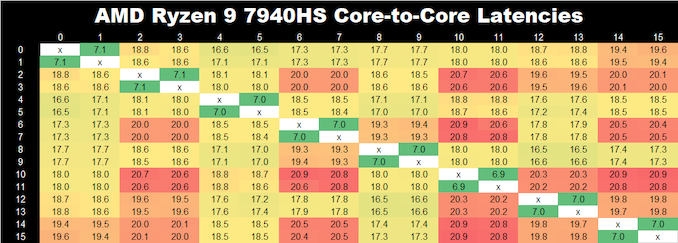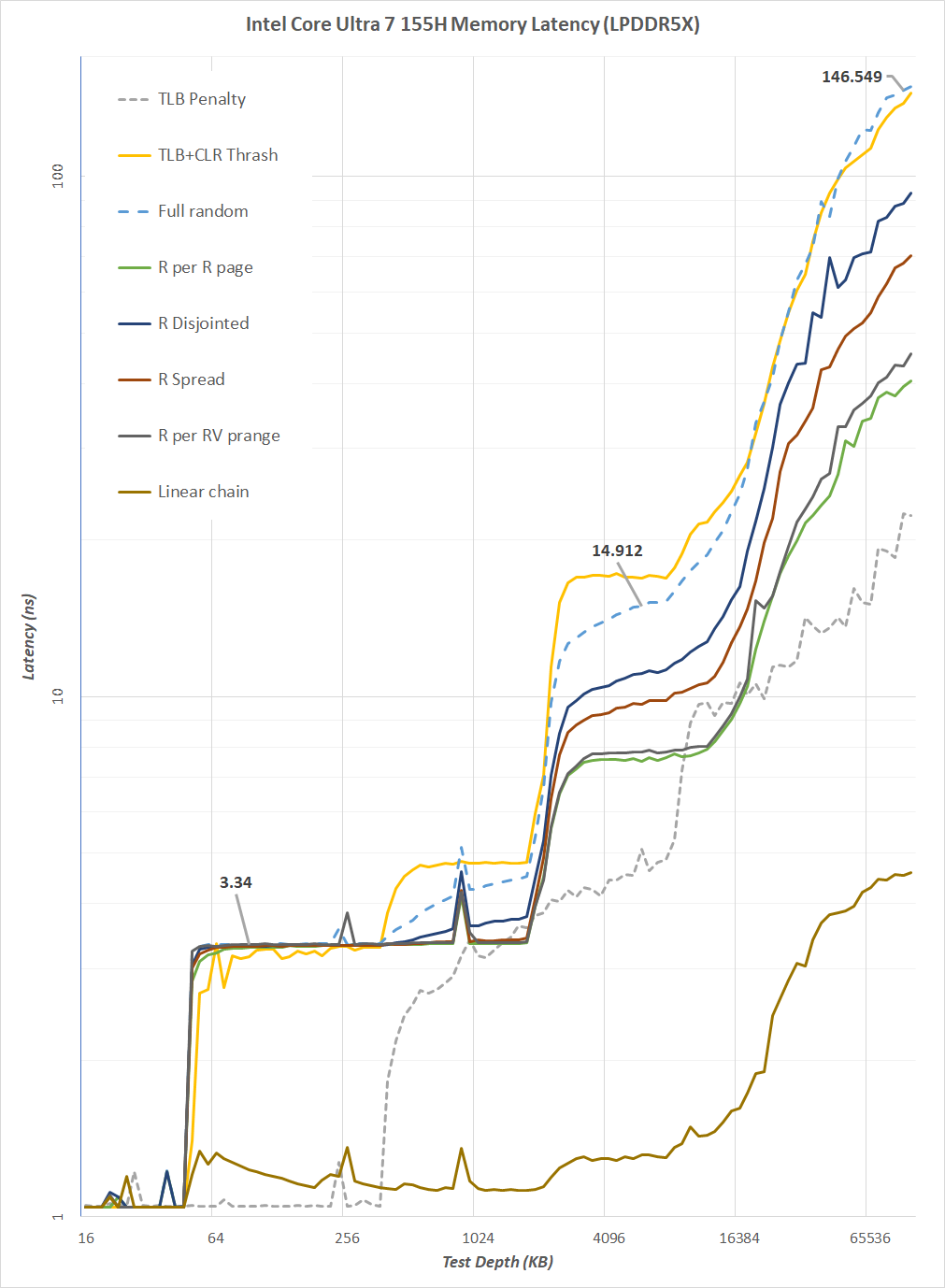The Intel Core Ultra 7 155H Review: Meteor Lake Marks A Fresh Start To Mobile CPUs
by Gavin Bonshor on April 11, 2024 8:30 AM ESTCore-to-Core Latency: Meteor Lake vs. Phoenix vs. Raptor Lake
As the core count of modern CPUs is growing, we are reaching a time when the time to access each core from a different core is no longer a constant. Even before the advent of heterogeneous SoC designs, processors built on large rings or meshes can have different latencies to access the nearest core compared to the furthest core. This rings true especially in multi-socket server environments.
But modern CPUs, even desktop and consumer CPUs, can have variable access latency to get to another core. For example, in the first generation Threadripper CPUs, we had four chips on the package, each with 8 threads, and each with a different core-to-core latency depending on if it was on-die or off-die. This gets more complex with products like Lakefield, which has two different communication buses depending on which core is talking to which.
If you are a regular reader of AnandTech’s CPU reviews, you will recognize our Core-to-Core latency test. It’s a great way to show exactly how groups of cores are laid out on the silicon. This is a custom in-house test, and we know there are competing tests out there, but we feel ours is the most accurate to how quick an access between two cores can happen.
In this core-to-core latency analysis, we'll compare the Intel Core Ultra 7 155H, based on their latest Meteor Lake architecture, directly to a similar processor from Raptor Lake, the Core i5-14600K. Both have the same 6P+8E core configuration, with the Core Ultra 7 155H coming with two Low Power Island (LP) Efficiency cores embedded within the SoC.
These LP E cores are based on the same Crestmont microarchitecture as the larger Efficiency cores within the compute tile but are designed to operate with a lower voltage-to-frequency (V/F) curve, emphasizing that they are designed to operate at an overall lower power envelope. The key idea is that the LP E cores offload the lightest and least demanding background tasks with the aid of Intel's Thread Director – and ideally, avoid powering up the compute tile altogether for mundane background threads.
Looking at the core-to-core latencies of the Intel Core Ultra 7 155H, which showcases the physical topology of the processor itself, there are a couple of interesting points to note. Firstly, Intel's Meteor Lake compute tile with both the P-core and E-cores that are built on the Intel 4 node employ a similar bi-directional cache coherence as per its previous architectures, such as Alder Lake and Raptor Lake. From Intel's previous heterogeneous architectures, such as Alder Lake and Raptor Lake,
Starting with the Redwood Cove (P) core cluster on the Core Ultra 7 155H, we can see that the inter-core latency access latencies across the P-cores range from 4.5 to 4.9 ns, which is very similar to that of Raptor Lake via the Core i5-14600K, which sits between 4.6 and 4.9 ns; this indicates that both have a very similar topology. Interestingly, Intel has placed a single P-core at the front of the topology, which has an inter-core latency of 5 ns. Going outside to contact other cores, the latency increases within the P-Core cluster up to 39.9 ns, which is very similar to Raptor Lake.
For the E-cores, the latencies shoot up to between 57.9 and 74.8 ns per each L1 access point, with the two first E-cores having a latency of just 5.0 ns. For reference, the Core i5-14600K, which is based on Raptor Lake, has lower efficiency core-to-core latencies of between 41.5 and 46 ns. Outside of the initial L1 access, the latencies shoot up, as expected, to between 45.2 and 75.4 ns at the top end of the scale.
Lastly, the Low-Power Island E-cores are designated as Core 20 and 21. They have much higher latencies of up to 152 ns, which isn't very efficient when communicating with cores in other clusters. They also have the longest route to take to reach any other core clusters, since they need to go off-die over to the compute tile to talk to the rest of the CPU cores. However, even between themselves, the core-to-core latency is still high, at 116.8 ns. This strongly emphasizes how the LP cores are not meant to be treated as part of the larger pool of CPU cores for multi-threaded tasks, and instead are best left to handle background activities.
Throwing AMD's Ryzen 9 7940HS into the mix, the Phoenix architecture uses AMD's Zen 4 cores on an FP8 chipset and is built using TSMC's 4 nm node. With a monolithic core and cache coherency structure, the inter-core-to-core latencies on this chip are higher than Intel's P-Core cluster on both Meteor Lake and Raptor Lake, with a consistent L1 range of between 7.0 and 7.1 ns. Hopping between other cores within the cluster on the Ryzen 9 7940HS, latencies hit up to 20.8 ns, which is much lower overall than the heterogeneous architecture Intel is using with P and E-cores while adding the LP E cores into the mix to push these latencies higher.
Cache Latencies
Examining the Core Ultra 7 155H's memory latency with LPDDR5X, the above graph looks at various test depths and shows the impact on latency through the different levels of cache. The baseline latency for linear memory access patterns remains consistently the lowest, with efficient[ prefetchers in using predictable patterns,
Across random access scenarios, the full random test exhibits higher latency across all depths, highlighting the increased time required for memory accesses when they are not sequential. This is a common challenge for CPUs when dealing with unpredictable data access, which is more typical than not within many real-world applications.
Latency inherently shoots skyward when we cross the L1 and L2 cache thresholds, as evident from the latency jumps at specific test depths. An example of this is at the 1024 KB test depth, where we can see an increase in latency for random access patterns. This means that the test depth exceeds the capability of the cache, as the Core Ultra 7 155H has to fetch data from the DRAM.
Focusing on Translation Lookaside Buffer (TLB) performance, our data indicates the Core Ultra 7 155H suffers a latency penalty whenever a TLB miss occurs (TLB Penalty line), which aligns with the expected behavior when data extends beyond the cache. The latency further skyrockets whenever TLB misses, and the TLB+CLR Thrash line points towards worst-case scenarios in memory access.
As the test depth extends to 16384 KB and beyond, nearly all memory access patterns converge towards higher latencies, indicating the reliance on main memory as the cache sizes are exceeded. This suggests that despite increasing latency with larger caches within Meteor Lake's memory hierarchy, the Core Ultra 7 155H still benefits from an overall larger cache capacity, which should result in higher performance with data stored within the cache instead of accessing data externally.
The Meteor Lake memory subsystem is nearly identical to that we've seen on Raptor Lake via the Core i5-14600K, which is also highlighted, and it seems designed to optimize for larger cache capacities while trying to negate any trade-offs in latencies. The Core Ultra 7 155H CPU does seem to navigate these trade-offs, managing various access patterns with varying efficiency, at least within the 1024 KB testing depth and below.
In contrast to AMD's Phoenix mobile architecture using Zen 4, which closely resembles the cache of Zen 3, albeit with more L2 and an uptick in cycles, we can see a spike in TLB+CLR Thrashing compared to Meteor Lake. Still, inherently, below the 1024 KB test depth, both memory substructures on Meteor Lake and Phoenix remain competitive. Beyond 1024 KB, we see higher latencies, which is a direct result of crossing the L1 and L2 TLB thresholds at 112 KB of L1 per P-core and 2 MB of L2 per P-core.














69 Comments
View All Comments
Ryan Smith - Thursday, April 11, 2024 - link
Hmm, interesting. We're going to have to double-check with Intel on that.Ark has it down as 8 GPU cores. However the official presentation from the December "launch" had it down as 7: https://images.anandtech.com/galleries/9400/Intel%...
It's not uncommon for Intel presentations to have errors. But they also crop up in Ark from time to time as well. So 8 is probably correct, but we should get confirmation just in case. Reply
meacupla - Friday, April 12, 2024 - link
Yeah, I only noticed the difference when I had to look up why MSI claw was using a 135H. ReplyRyan Smith - Friday, April 12, 2024 - link
And Intel has since confirmed it to be 8. The article (and past articles with the bad info) have been updated. Thanks for pointing that out, meacupla! ReplyThe_Assimilator - Thursday, April 11, 2024 - link
An entire page, and an entire paragraph in the conclusion, wasted on pointless AI nonsense. Nobody reading this site cares about that rubbish, stop wasting our time. ReplyThe_Assimilator - Thursday, April 11, 2024 - link
Also good to see Intel's "revolutionary" new chip pulling the exact same BS as their past chips have regarding power. "28W" that actually uses 65W, incredible. Replymode_13h - Monday, April 15, 2024 - link
The only thing your comment tells me is that the AI benchmarks should be updated to include more typical real-world AI usage examples. Aside from things like Stable Diffusion, where most readers are likely to encounter AI in their everyday computing is in apps like video conferencing (background replacement, noise suppression) and photo editing. ReplyNextGen_Gamer - Thursday, April 11, 2024 - link
Those iGPU numbers are way off - the Socket AM5 8700G is obviously going to outperform the mobile variant across the board, based on TDP alone. Even if the mobile version was using LPDDR5X memory (which in this case it wasn't), it wouldn't be enough to close the gap.AnandTech: ever given any though to getting all these chips in mini PC form? Most of those allow much more control over the TDP, along with memory/SSD being your own picks. And then that all but eliminates the cooling issues of a laptop. Reply
meacupla - Thursday, April 11, 2024 - link
While you can get a 7940HS miniPC now, Core Ultra miniPCs aren't out yet.Core Ultra laptops are showing up at reviewers just now, but they've barely left the gate in terms of availability to regular consumers.
Asus announced NUC 14 two weeks ago, on Mar 27. They are just now being listed at various retailers, so I would expect them to show up in stock a month or two from now. Reply
ricebunny - Friday, April 12, 2024 - link
My retailer indicates that the Asus Nuc 14Pro+ is available. I would be curious to see how the 155H performs in that chassis with a lot more thermal headroom. Replyhaplo602 - Thursday, April 11, 2024 - link
"On the flip side, as we established with our look at power consumption, the Ryzen 9 7940HS laptop is able to sustain a much higher TDP overall – so that memory bandwidth deficit is counterbalanced by a sizable TDP advantage."Are you really a tech review site ? In this case memory bandwidth is king with TDP a distant second (given comparable compute power). And Intel has a huge advantage with LPDDR5X here that it manages to waste somehow.
Also the official title is CPU review and there are graphs for BATTERY CHARGE TIME ??? Really ? What does that have to do with the CPU at all ? Reply